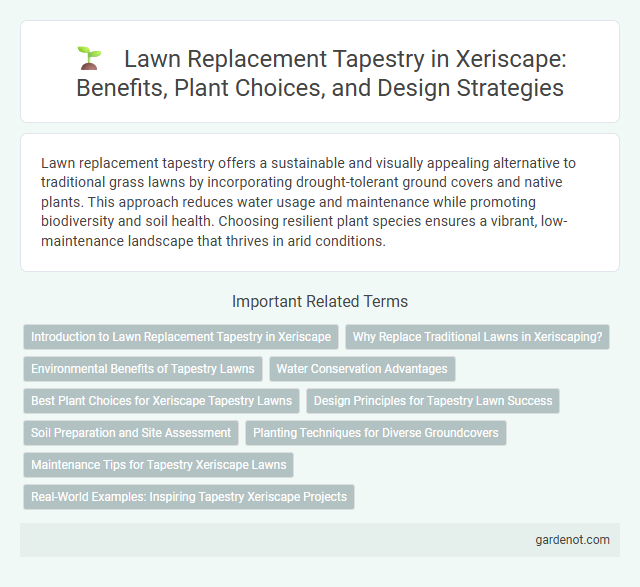Lawn replacement tapestry offers a sustainable and visually appealing alternative to traditional grass lawns by incorporating drought-tolerant ground covers and native plants. This approach reduces water usage and maintenance while promoting biodiversity and soil health. Choosing resilient plant species ensures a vibrant, low-maintenance landscape that thrives in arid conditions.
Introduction to Lawn Replacement Tapestry in Xeriscape
Lawn replacement tapestry in xeriscape transforms traditional grass areas into visually appealing, low-water-use ground covers. Utilizing drought-tolerant plants like sedums, creeping thyme, and native grasses, it reduces irrigation needs while enhancing biodiversity. This sustainable approach conserves water, minimizes maintenance, and creates resilient, vibrant landscapes ideal for arid and semi-arid regions.
Why Replace Traditional Lawns in Xeriscaping?
Replacing traditional lawns with xeriscape tapestry significantly reduces water usage, as conventional grass requires extensive irrigation that strains local water supplies. Xeriscape plants, such as drought-tolerant native grasses, succulents, and ground covers, thrive in arid conditions and maintain aesthetic appeal with minimal maintenance. This sustainable landscaping approach not only conserves water but also enhances biodiversity and reduces the need for fertilizers and pesticides.
Environmental Benefits of Tapestry Lawns
Tapestry lawns, as a sustainable alternative to traditional turfgrass, significantly reduce water consumption by incorporating drought-tolerant plant species ideal for xeriscaping. These diverse, low-maintenance landscapes enhance soil health through improved microbial activity and organic matter retention, supporting local biodiversity and reducing the need for chemical fertilizers. By minimizing irrigation and chemical inputs, tapestry lawns also lower carbon emissions associated with lawn maintenance, contributing to a healthier environment.
Water Conservation Advantages
Xeriscape lawn replacement tapestries significantly reduce water consumption by utilizing drought-tolerant plants that thrive with minimal irrigation. These tapestries enhance water conservation by creating dense ground cover that limits soil evaporation and prevents runoff. Implementing xeriscape designs can cut outdoor water use by up to 50%, promoting sustainable landscaping practices.
Best Plant Choices for Xeriscape Tapestry Lawns
Best plant choices for xeriscape tapestry lawns include drought-tolerant species like blue grama grass, buffalo grass, and creeping thyme, which provide a green, textured appearance with minimal water use. Selecting native plants such as lavender, sedum, and ornamental grasses enhances soil health and supports local pollinators while reducing irrigation needs. Incorporating deep-rooted perennials and ground covers optimizes water retention and creates a resilient, low-maintenance landscape perfect for xeriscape design.
Design Principles for Tapestry Lawn Success
Lawn replacement with xeriscape tapestry involves selecting drought-tolerant plants that create a dense, visually appealing ground cover to minimize water use. Emphasizing plant diversity, layering textures, and using native species helps develop a resilient, low-maintenance landscape that thrives in arid conditions. Proper soil preparation and strategic planting patterns enhance water retention and support healthy root development for long-term tapestry lawn success.
Soil Preparation and Site Assessment
Lawn replacement tapestry requires thorough soil preparation and site assessment to ensure successful establishment and sustainability. This process includes testing soil pH and texture, removing existing turf, and amending soil with organic matter to improve drainage and nutrient content. Proper evaluation of sunlight exposure, slope, and existing vegetation guides the selection of drought-tolerant plants suitable for xeriscaping.
Planting Techniques for Diverse Groundcovers
Using diverse groundcovers in xeriscape lawn replacement enhances water conservation and reduces maintenance by selecting drought-tolerant species such as sedum, creeping thyme, and ice plant. Proper planting techniques include soil preparation with organic matter, spacing plants to allow for growth and weed suppression, and incorporating mulch to retain moisture and regulate soil temperature. Integrating varied textures and heights in groundcovers creates an aesthetically pleasing, sustainable landscape that minimizes irrigation needs.
Maintenance Tips for Tapestry Xeriscape Lawns
Tapestry xeriscape lawns require minimal watering and pruning, making them highly drought-resistant and low-maintenance. Regularly removing weeds and applying a thin layer of organic mulch helps retain soil moisture and prevent weed growth. Periodic inspection for pests and occasional trimming of overgrown plants promote a healthy and visually appealing xeriscape lawn.
Real-World Examples: Inspiring Tapestry Xeriscape Projects
Tapestry xeriscape projects, such as Denver Botanic Gardens' Waterwise Garden and Phoenix's Desert Botanical Garden, showcase vibrant, drought-tolerant plant arrays that replace traditional lawns while enhancing biodiversity. These landscapes utilize native plants like agave, yucca, and penstemon to create visually appealing, sustainable outdoor spaces requiring minimal irrigation. By integrating layered textures and colors, tapestry xeriscapes demonstrate effective water conservation without sacrificing aesthetic value in arid urban environments.
Lawn replacement tapestry Infographic

 gardenot.com
gardenot.com